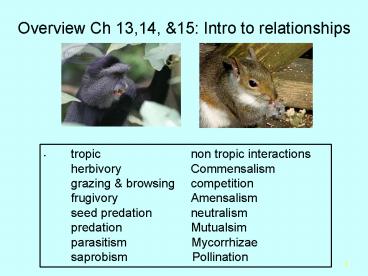Overview Ch 13,14, - PowerPoint PPT Presentation
1 / 26
Title:
Overview Ch 13,14,
Description:
Definitions of terms applying to relationships ... Physical contest, visual, odor cues. 8. Interspecific Competition Among Herbaceous Plants ... – PowerPoint PPT presentation
Number of Views:75
Avg rating:3.0/5.0
Title: Overview Ch 13,14,
1
Overview Ch 13,14, 15 Intro to relationships
- tropic non tropic
interactions herbivory
Commensalism grazing browsing
competition frugivory
Amensalism seed predation
neutralism predation
Mutualsim parasitism
Mycorrhizae saprobism
Pollination
2
Definitions of terms applying to relationships
- Trophic terms hebivory, (know terms from
video), carnivore, omnivore - parasitism - 1 benefits (P) 1 is harmed (host)
- competition - both species are harmed, fewer
resources - predation - 1 benefits (predator) 1 is harmed
(prey) - saprobism - eating dead material no
impact
3
Definitions cont
- Amensalism A symbiotic relationship between
organisms in which one species is harmed or
inhibited and the other species is unaffected.- - Mutualism - Both species benefit by the
interaction between the two species. - Ex. Pollination
- Commensalism - at table together'. This is a
symbiotic relationship between two species in
which one species benefits and the has no effect. - neutralism - 2 species exist in same area with
no impact on each other
4
Introduction to relationships
- Haskells Gain-Loss Matrix
- Effect on weak species
-
- 0
- effect on -
competition amensalism
parasitism - strong species 0 amensalism
neutralism commensalism
Predation commensalism mutualism
5
Competition Chapter 13
6
Modes of Competition
- Interference
- Direct aggressive interaction between
individuals. - Intraspecific
- Competition with members of own species.
- Interspecific
- Competition between individuals of two species -
reduces fitness of both.
7
Types of competition cont
- Scramble -Food resources
- Contest
- Head to head battles
- Mates
- Territory
- Physical contest, visual, odor cues
8
Interspecific Competition Among Herbaceous Plants
- Self-Thinning
- Plant growth rates and weights have been found to
increase in low density populations. - Competition is more intense at higher pop
densities. - mortality among competing plants.
9
Interspecific Competition Among Herbaceous Plants
10
Lotka Volterra
- In general, LV predicts coexistence of two
species when, for both species, interspecific
competition is weaker than intraspecific
competition. - Predict population growth for the two species
will stop when - N1K 1-?12 N2 and N2 K 2- ?21 N1
- Zero Growth Isoclines
- Above Population increasing
- Below Population decreasing
- Coexistence of two species is only possible when
isoclines cross.
11
Lotka Volterra
- Effect of interspecific competition on population
growth of each species - dN1 / dt rm1N1 ((K1-N1-?12N2) / K1)
- dN2 / dt rm2N2 ((K2-N2-?21N1) / K2)
- ?12 Effect of individual of species 2 on rate
of pop. growth of species 1. - ?21 Effect of individual of species 1 on rate
of pop. growth of species 2.
12
Lotka Volterra
13
Niches
- Niche Summarizes environmental factors that
influence growth, survival, and reproduction of a
species. - Type of food eaten, area it lives in.
14
Niches
- Hutchinson defined niche as
- n-dimensional hyper-volume
- n equates the number of environmental factors
important to survival and reproduction of a
species. - Fundamental niche hypervolume many env
factors considered such as food, nest sites,
mating strategies. - Realized niche (also called ecological niche)
includes interactions such as competition that
may restrict environments where a species may
live. - Includes inter and intra specific competition
15
Feeding Niches of Galapagos Finches
- Grant found differences in beak size among ground
finches translates directly into diet. - Size of seeds eaten can be estimated by measuring
beak depths. - Individuals with deepest beaks fed on hardest
seeds. - After 1977 drought, the remaining seeds were
very hard. Thus, mortality was most heavy in
birds with smaller beaks.
16
Feeding Niches of Galapagos Finches
17
Gause Principle of Competitive Exclusion
Pileated Downy Northern Flicker
- Two species with identical niches cannot coexist
indefinitely. - One will be a better competitor and thus have
higher fitness and eventually exclude the other. - 4 C rule (Complete Competitors Cannot Coexist
- Compare niches of 5 species of woodpeckers
18
Paramecia Lab Experiments
- Gause demonstrated resource limitation with
Paramecium caudatum and Paramecium aurelia in
presence of two different concentrations of
Bacillus pyocyaneus. - When grown alone, carrying capacity determined by
intraspecific competition. - When grown together, P. caudatum quickly
declined. - Reduced resource supplies increased competition.
19
Paramecia Lab Experiments
20
Competition and Niches
- Competition can restrict species to their
realized niches. - But if competitive interactions are strong and
pervasive enough, they may produce an
evolutionary response in the competitor
population. - Changes fundamental niche.
21
Niche Overlap and Competition Between Barnacles
- Connell discovered interspecific competition in
barnacles. Balanus plays a role in determining
lower limit of Chthamalus within intertidal zone. - Did not account for all observed patterns.
- Predation by starfish
22
(No Transcript)
23
Competition and Niches of Small Rodents
- Brown studied competition among rodents in
Chihuahuan Desert. - Predicted if competition among rodents is mainly
for food, then small granivorous rodent
populations would increase in response to removal
of larger granivorous rodents. - Insectivorous rodents would show little or no
response. - Results supported hypothesis.
24
Competition and Niches of Small Rodents
25
Character Displacement resource partitioning
- degree of competition depends on degree of niche
overlap, interspecific competition is predicted
to lead to directional selection for reduced
niche overlap. - Resource Partioning ex. beaks of finches
- Compare 5 types of beaks in Darwins finches
26
Character Displacement































